At U.S. Global Investors, we find it curious that many investors still don’t realize what a significant role royalty and streaming companies play in the mining business. We think that now is a good time for investors to acquaint themselves with or take another look at royalty companies, which make up a sizeable portion of our just-launched U.S. Global GO GOLD and Precious Metal Miners ETF (GOAU).

Here are the top six things we believe investors should know about this specialized sector.
1. What Is a Royalty Company?
Royalty companies, sometimes called streaming companies, serve a special role in the mining industry. Developing a mine property to start producing gold or other precious metal is an expensive, time-consuming process. Infrastructure needs to be built out, permits applied for, laborers hired and more.
A royalty company serves as a specialized financier that helps fund exploration and production projects for cash-strapped mining companies. In return, it receives royalties on whatever the project produces, or rights to a “stream,” an agreed-upon amount of gold, silver or other precious metal.

2. Many Gold Royalty Companies Have Still Been Outperforming Gold
When looking over the last 12 months as of March 31, we see that many of the royalty companies we favor have outperformed gold. While this is indeed remarkable, it is important to remember that royalty companies do have a robust business model. Their ability to generate revenue in times when the price of gold, or other precious metal, is both rising and faling is part of what makes them attractive.
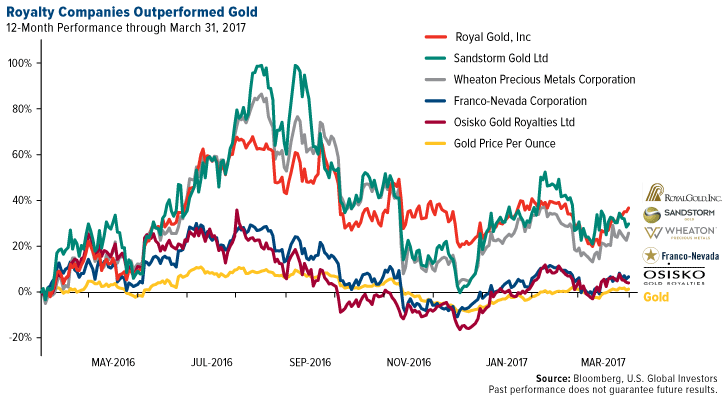
3. Remember Real Interest Rates
There’s no question that the gold price is volatile. It’s important for investors to remember that gold has historically shared a strong inverse relationship with real interest rates, which is what you get when you subtract inflation from nominal, or headline, interest rates. (We used the real 5-year Treasury yield as a proxy.) You can see in the chart below that as rates fell, the price of gold rose, and vice versa.
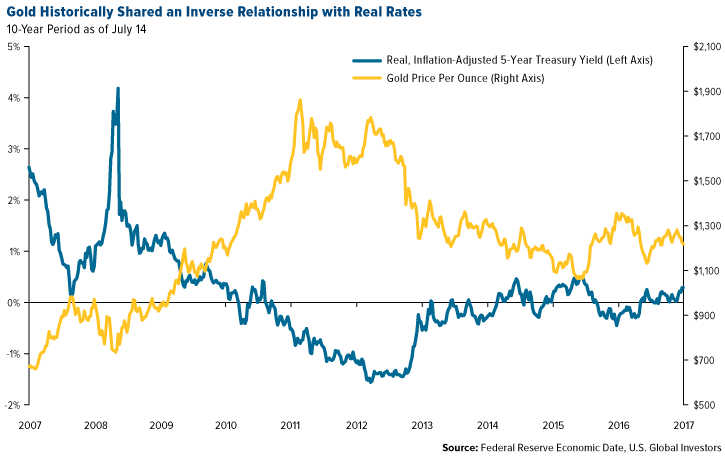
This is another reason why we prefer the royalty model. Since royalty companies set fixed, lower-than-market prices for mining output, they can better manage the volatility that is inherent in the gold market. For example, Wheaton Precious Metals’ 19 streaming agreements in 2016 entitled the company to buy silver at an average price of $4.42 an ounce and gold at $391 an ounce. That’s quite a discount, as silver averaged a little over $17 an ounce in 2016, while gold averaged $1,250, according to Kitco data.
4. Speaking of Revenue…
Many royalty companies have traditionally reported very high revenue per employee. This is still true. Take a look at the 12-month revenue per employee of Franco-Nevada, Royal Gold and Wheaton Precious Metals. Wheaton has only around 35 employees, according to the Financial Times, but boasts one of the highest rates in the world, generating $25.8 million per employee. By comparison, Newmont, which employs around 30,000 people, generated $310,000 per employee during the same period. Barrick also falls short by comparison.
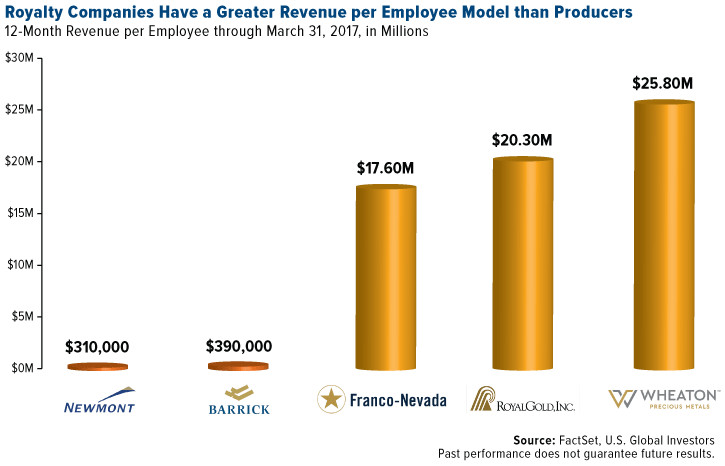
5. Attractive Dividend Growth
Paying dividends is important to investors, as it reflects the health of a company in terms of its cash flow and profits. Even more favorable in the eyes of investors is a company that is growing its dividends. Between 2012 and 2017, royalty companies had a combined annual dividend growth rate of 17 percent. Compare that to 11 percent growth for the S&P 500 Index, and as low as negative 23 and negative 32 percent for global and North American precious metal miners.
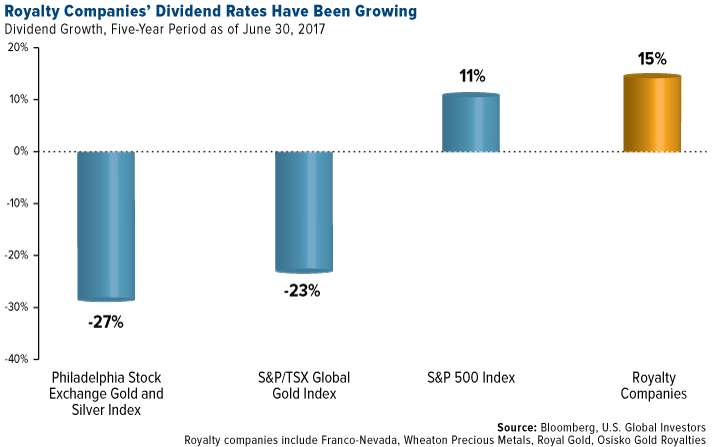
In fact, 2017 marks Franco-Nevada’s 10th straight year of dividend increases since the company went public in 2007.
6. Less Reliance on Debt
We believe royalty companies are better allocators of capital than some of the biggest gold miners. Take a look at Newmont Mining, which has a 43 percent debt-to-equity ratio, and Barrick, which has a massive 91 percent. By comparison, many of the royalty companies have much lower debt. Franco-Nevada has zero debt. This history of profitability and fiscal discipline is one of the main reasons we find royalty companies so attractive.
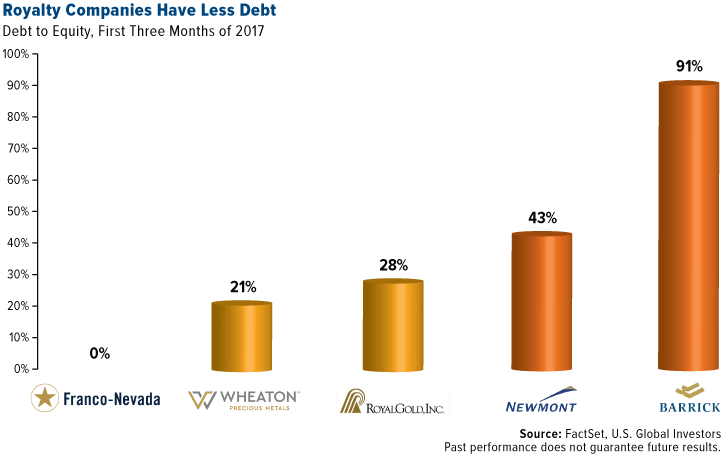
GOAU and Royalty Companies
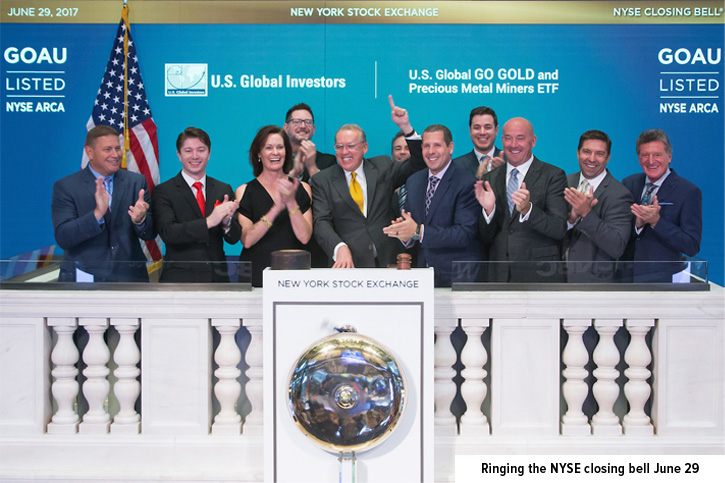
Our recently-launched U.S. Global GO GOLD Precious Metal Miners ETF (GOAU), which tracks the U.S. Global Go Gold and Precious Metal Miners Index (GOAUX), provides investors access to companies engaged in the production of precious metals either through active (mining or production) or passive (owing royalties or production streams) means.
About 30 percent of GOAU, in fact, is devoted to royalty companies, which we regard as the “smart money” of the metals and mining space. This, we believe, can help investors gain exposure to precious metals while mitigating some of the most common risks traditional miners face. Because some of them historically taken on very little debt and have offered increased dividends, royalty companies may be an attractive option for precious metals investors.
All opinions expressed and data provided are subject to change without notice. Some of these opinions may not be appropriate to every investor.
The Philadelphia Gold and Silver Index (XAU) is a capitalization-weighted index that includes the leading companies involved in the mining of gold and silver. The S&P/TSX Global Gold Index is an international benchmark tracking the world’s leading gold companies with the intent to provide an investable representative index of publicly-traded international gold companies. The S&P 500 Stock Index is a widely recognized capitalization-weighted index of 500 common stock prices in U.S. companies. It is not possibly to invest directly in an index.
Dividend growth rate is the annualized percentage rate of growth that a particular stock’s dividend undergoes over a period of time. There is no guarantee that the issuers of any securities will declare dividends in the future or that, if declared, will remain at current levels or increase over time.
Cash flow is the total amount of money being transferred into and out of a business, especially as affecting liquidity.
Gold, precious metals, and precious minerals funds may be susceptible to adverse economic, political or regulatory developments due to concentrating in a single theme. The prices of gold, precious metals, and precious minerals are subject to substantial price fluctuations over short periods of time and may be affected by unpredicted international monetary and political policies. We suggest investing no more than 5% to 10% of your portfolio in these sectors.
